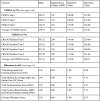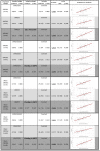Potential Impact of Pass/Fail Scores on USMLE Step 1: Predictors of Excellence in Obstetrics and Gynecology Residency Training
- PMID: 34805529
- PMCID: PMC8597065
- DOI: 10.1177/23821205211037444
Potential Impact of Pass/Fail Scores on USMLE Step 1: Predictors of Excellence in Obstetrics and Gynecology Residency Training
Abstract
Aim: The study aims to determine resident applicant metrics most predictive of academic and clinical performance as measured by the Council of Resident Education in Obstetrics and Gynecology (CREOG) examination scores and Accreditation Council for Graduate Medical Education (ACGME) clinical performance (Milestones) in the aftermath of United States Medical Licensing Examination Scores (USMLE) Step 1 becoming a pass/fail examination.
Methods: In this retrospective study, electronic and paper documents for Wayne State University Obstetrics and Gynecology residents matriculated over a 5-year period ending July 2018 were collected. USMLE scores, clerkship grade, and wording on the letters of recommendation as well as Medical Student Performance Evaluation (MSPE) were extracted from the Electronic Residency Application Service (ERAS) and scored numerically. Semiannual Milestone evaluations and yearly CREOG scores were used as a marker of resident performance. Statistical analysis on residents (n = 75) was performed using R and SPSS and significance was set at P < .05.
Results: Mean USMLE score correlated with CREOG performance and, of all 3 Steps, Step 1 had the tightest association. MSPE and class percentile also correlated with CREOGs. Clerkship grade and recommendation letters had no correlation with resident performance. Of all metrics provided by ERAS, none taken alone, were as useful as Step 1 scores at predicting performance in residency. Regression modeling demonstrated that the combination of Step 2 scores with MSPE wording restored the predictive ability lost by Step 1.
Conclusions: The change of USMLE Step 1 to pass/fail may alter resident selection strategies. Other objective markers are needed in order to evaluate an applicant's future performance in residency.
Keywords: CREOG; Step 1; USMLE; in-service examination; resident selection.
© The Author(s) 2021.
Conflict of interest statement
Declaration of Conflicting Interests: The authors declared no potential conflicts of interest with respect to the research, authorship, and/or publication of this article.
Figures





Similar articles
-
Do U.S. medical licensure examination step 1 scores correlate with council on resident education in obstetrics and gynecology in-training examination scores and American board of obstetrics and gynecology written examination performance?Mil Med. 2007 Jun;172(6):640-3. doi: 10.7205/milmed.172.6.640. Mil Med. 2007. PMID: 17615848
-
United states medical licensing examination scores as a predictor of performance on the annual council of resident education in obstetrics and gynecology examinations.J Reprod Med. 2014 Jan-Feb;59(1-2):17-9. J Reprod Med. 2014. PMID: 24597281
-
Can ACGME Milestones predict surgical specialty board passage: an example in Obstetrics and Gynecology.Clin Exp Obstet Gynecol. 2021 Oct 15;48(5):1048-1055. doi: 10.31083/j.ceog4805168. Clin Exp Obstet Gynecol. 2021. PMID: 34720368 Free PMC article.
-
The USMLE® STEP 1 Pass or Fail Era of the Vascular Surgery Residency Application Process: Implications for Structural Bias and Recommendations.Ann Vasc Surg. 2023 Aug;94:195-204. doi: 10.1016/j.avsg.2023.04.018. Epub 2023 Apr 28. Ann Vasc Surg. 2023. PMID: 37120072 Review.
-
The USMLE Step 1 Pass/Fail Reporting Proposal: The APDR Position.Acad Radiol. 2019 Oct;26(10):1400-1402. doi: 10.1016/j.acra.2019.06.004. Epub 2019 Aug 2. Acad Radiol. 2019. PMID: 31383545 Review.
Cited by
-
The Effect of Pass/Fail Exam Grading on Exam Performance in a Pediatric Clerkship.J Med Educ Curric Dev. 2023 Nov 23;10:23821205231212771. doi: 10.1177/23821205231212771. eCollection 2023 Jan-Dec. J Med Educ Curric Dev. 2023. PMID: 38025027 Free PMC article.
-
Impact of a USMLE Step 2 Prediction Model on Medical Student Motivations.J Med Educ Curric Dev. 2025 Feb 18;12:23821205251321812. doi: 10.1177/23821205251321812. eCollection 2025 Jan-Dec. J Med Educ Curric Dev. 2025. PMID: 39974318 Free PMC article.
-
The US Residency Selection Process After the United States Medical Licensing Examination Step 1 Pass/Fail Change: Overview for Applicants and Educators.JMIR Med Educ. 2023 Jan 6;9:e37069. doi: 10.2196/37069. JMIR Med Educ. 2023. PMID: 36607718 Free PMC article.
References
-
- United States Medical Licensing Examination, Summary Report and Preliminary Recommendations from the Invitational Conference on USMLE Scoring 2019; https://www.usmle.org/pdfs/incus/incus_summary_report.pdf.
-
- United States Medical Licensing Examination. Invitational Conference on USMLE Scoring: change to pass/fail score reporting for Step 1, 2020. .https://www.usmle.org/incus/
-
- The National Resident Matching Program. Results of the 2018 NRMP Program Director Survey. 2018; https://www.nrmp.org/wp-content/uploads/2018/07/NRMP-2018-Program-Direct....
-
- Wells M, Polmear M, Nesti LJ, Dunn JC. Factors considered when ranking military orthopedic surgery residency candidates. Mil Med. 2020;185:e1603-e1607. - PubMed
LinkOut - more resources
Full Text Sources

